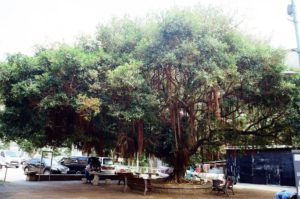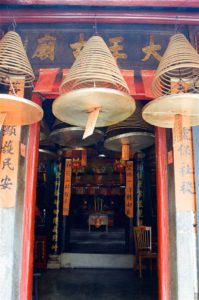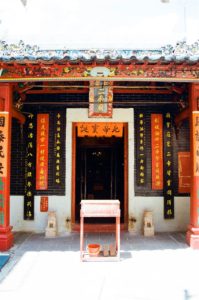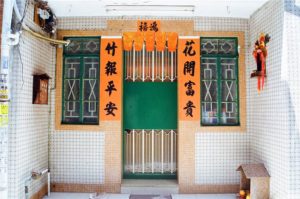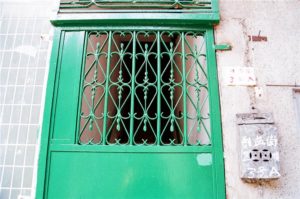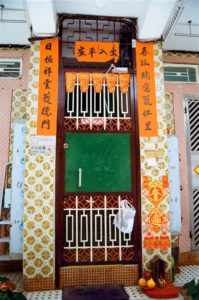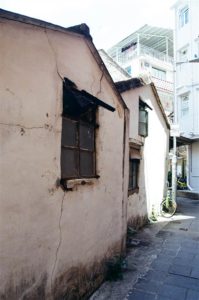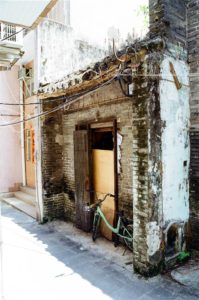Yuen Long’s Old Market (The Qing Dynasty Street)

Yuen Long today is a thriving town in northwestern New Territories, mostly known for its great food. It is also an area heavily populated with indigenous villages. As such, Yuen Long had a long history of development in Hong Kong, going way back to the Song Dynasty.
It only came to my attention recently that Yuen Long has an Old Market area, which spans the three streets of Cheung Shing Street, Lee Yick Street and Wine Street. I was intrigued, as the local tour agencies call it the “Qing Dynasty Street.” I paid a short visit and read up on its history.
History of the Old Market
During the Qing Dynasty, the Yuen Long Old Market was the heart of economic activities. Throughout the Qing Dynasty, it was the major marketplace in all of Hong Kong. Due to the imperial edict of coastal evacuation, the market stopped running. During the 8th year of the Kangxi Reign (1699), the jinshi[i] village gentry Tang Man-wai of Kam Tin (then known as Shum Tin) submitted a formal request to the Qing Court to revive the Yuen Long region’s economy. The Yuen Long Old Market was a result of this initiative. The Tang’s re-established the market in the general area of Nam Bin Wai.
This geographical location was a very good choice for a market. The land lied in the northwestern part of Hong Kong, bordered the southern shore of the Shenzhen River west, where the Shan Pui River and Kam Tin River intersected. This enabled the people of the neighborhood villages, including Ping Shan, Kam Tin, and Shap Pat Heung to arrive by boat. As such, the market had quickly garnered the presence of vendors selling all kinds of necessities. From daily veggies to letter-writing services, the Yuen Long Old Market had plenty to offer.
“Hui” – A Distinct Idea of a Marketplace
In Cantonese, the Yuen Long Old Market is the Yuen Long “Kau Hui” (“kau” meaning old, and “hui” meaning market). Yet the “hui” has a nuanced difference from the more commonly used word “shi,” which, for the lack of an alternative word in English, also means market.
At the Yuen Long Old Market’s new beginning, it was a “hui” consisting of temporary vendors selling their goods in make-shift stalls. They began the day early at dawn, and they would wrap up the day’s trade after noon. The “hui” elicits the idea of mobility, versus the more stable “shi.” Craftsmen of all kinds would offer one-off services, such as barbers, fortune tellers, or letter-writers.
As opposed to “shi,” “hui” refers to a kind of marketplace that has more downtime. On certain days when the “hui” opens for business, it draws vendors from all walks of life. Yet in any given month the “hui” would open for only about ten days or so. The “shi,” on the other hand, is more permanent, although perhaps operating on a smaller scale. As times progressed, however, the distinction between “hui” and “shi” slowly disappeared. The Cantonese language no longer distinguishes between the two. A marketplace, in old Cantonese, is simply known as “hui shi.”
As business continued to develop, people built and operated standard stores in the Yuen Long Old Market. The earlier establishments were grocers. Then further development invited the presence of food and beverages, tools, services and even entertainment industries. It did become a one-stop market that met all of people’s daily and lifestyle needs.
Management of Yuen Long’s Old Market
Tang Man-wai set up the Kwong Yu Tong to handle the day-to-day management of the Old Market. As it was common to other marketplaces in the New Territories, the commission system (gong ching) ensured a steady stream of profits for the market owners. At each transaction, both buyers and sellers share equally the commission, a rate that depended on the quantity of the goods changing hands. Having won a bidding process, the holder of “ching” can collect these commissions for the period of one year typically. Then the holder of “ching” would pay a rental fee to Kwong Yu Tong. Kwong Yu Tong used these funds for maintenance and community development.
Because Tang Man-wai’s family monopolized this space, the commission system was rife with corruption. And this feature could have contributed to the downfall of the Old Market, which had a glorious 240 years of operation.
The Rise of Yuen Long’s New Market
The parts of Yuen Long bustling with economic activities today are actually the Yuen Long New Market (“san hui.”) During the early 20th century, the Yuen Long Chung riverbeds were clogged, causing significant inconvenience for transport by boats. The New Market also came about due to some villagers’ discontent with the long-time monopoly of land rights and profits in the Old Market by the Tang Man-wai family.
In 1915, Yuen Long’s New Market completed its basic structures, made possible by a pooling of funds from a number of village leaders. The Hop Yick Company was responsible for the management of the New Market.[ii] The features of the market included wide-open space for store fronts and a plaza for street stalls. Most importantly, the owners established an independent commission system that ensured fair trade. The New Market became very popular, causing the Old Market to gradually phase out in significance.
The Visit
I exited the Yuen Long MTR Station at Exit B. Having passed the Nam Bin Wai village (see picture below), I walked on and passed by the thriving banyan tree. That is the way to Cheung Shing Street, the main street that runs through the Old Market area.
I took a leisurely walk within this area and it took me about 30-40 minutes to finish the walk.
The Heritage Sites of Yuen Long Old Market
Most of the old buildings of the Qing Dynasty have now been rebuilt into modern homes. Some heritage still remains, however. I took a quick tour of the area and saw three main structures that are still here today.
The Po Yuen Pawn

The Po Yuen Pawn is the oldest pawn site in Hong Kong. It was built during the mid to late 18th century by a descendant of the Tang clan, Tang Lim-ming. The blue brick structure stands beautifully today, unfazed by the currents of history.
The Po Yuen Pawn served as the vendors’ go-to store for cash flow. They would pawn a piece of valuable in exchange for cash. When they have made their rounds trading at the market, and have earned money, they would redeem the pawned good.
The Po Yuen Pawn shut down during the Japanese Occupation of the 1940s, and remains closed today.
One can only imagine the kind of big money that used to come and go at this type of establishment.
Tai Wong Temple
The Tai Wong Temple has stood its time of 340 years since the inception of the Yuen Long Old Market. It is the oldest building in the Old Market area. The resident gods are Hong Shing and Hau Wong.
Yi Tai Temple
The Yi Tai Temple has had at least 300 years of history. The resident gods are Pak Tai and Kwan Tai. They were revered as the gods of commerce.
These temples served more than religious purposes. As a social and community space, they were the venues for dispute resolution and policy-making by the village leaders.
The Old Market Today
Although most of the buildings in this area are modern homes, some do retain an old-fashioned feel. They were clearly 20th century buildings, which by now can be deemed historic. These are the views of the Old Market area now.
Sources
All historical descriptions of Yuen Long’s Old Market came from Society of Hong Kong History, Hong Kong History in Historical Artefacts (Chin. 2014) at 67-74.
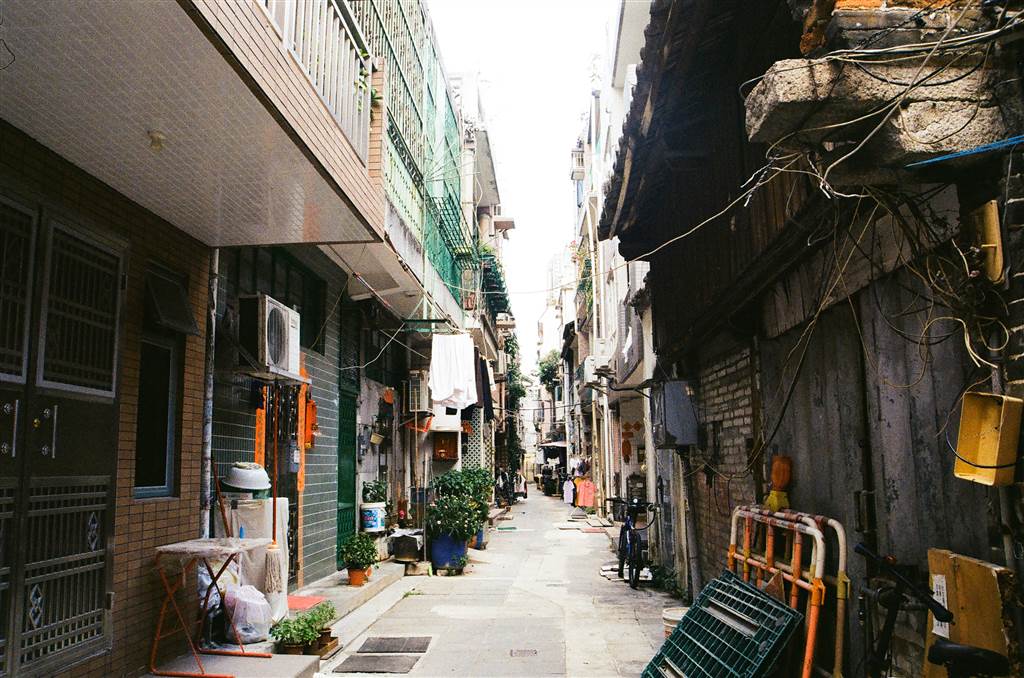
[i] The title “jinshi” is given to those who has past the final level of Qing Dynasty’s imperial civilian examination. As such, Tang Man-wai was a reputable village gentry, in addition to being a member of a prominent Tang indigenous family in Yuen Long then.


